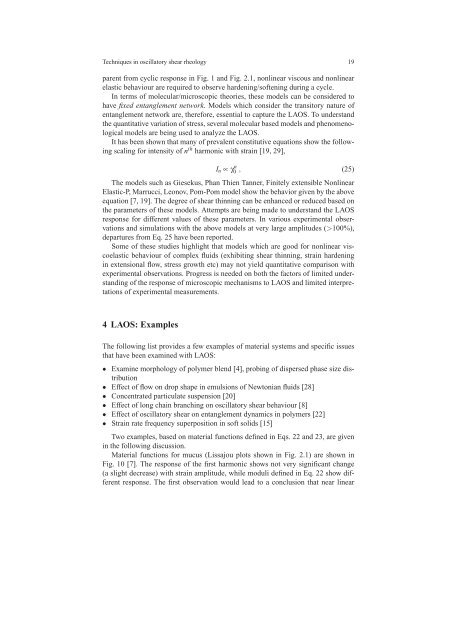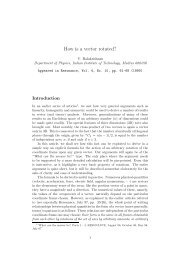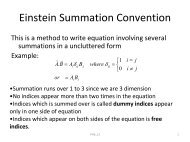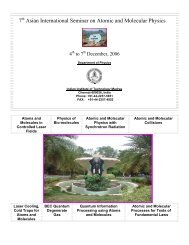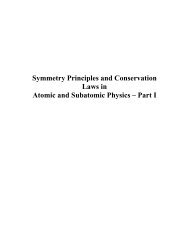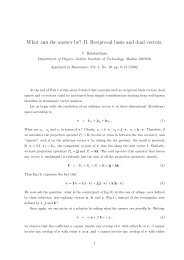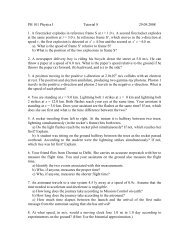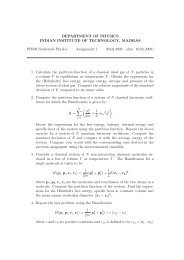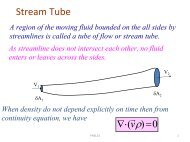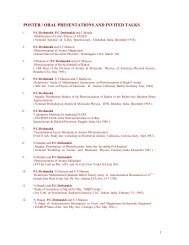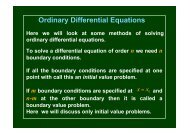Techniques in oscillatory shear rheology - Indian Institute of ...
Techniques in oscillatory shear rheology - Indian Institute of ...
Techniques in oscillatory shear rheology - Indian Institute of ...
You also want an ePaper? Increase the reach of your titles
YUMPU automatically turns print PDFs into web optimized ePapers that Google loves.
<strong>Techniques</strong> <strong>in</strong> <strong>oscillatory</strong> <strong>shear</strong> <strong>rheology</strong> 19parent from cyclic response <strong>in</strong> Fig. 1 and Fig. 2.1, nonl<strong>in</strong>ear viscous and nonl<strong>in</strong>earelastic behaviour are required to observe harden<strong>in</strong>g/s<strong>of</strong>ten<strong>in</strong>g dur<strong>in</strong>g a cycle.In terms <strong>of</strong> molecular/microscopic theories, these models can be considered tohave fixed entanglement network. Models which consider the transitory nature <strong>of</strong>entanglement network are, therefore, essential to capture the LAOS. To understandthe quantitative variation <strong>of</strong> stress, several molecular based models and phenomenologicalmodels are be<strong>in</strong>g used to analyze the LAOS.It has been shown that many <strong>of</strong> prevalent constitutive equations show the follow<strong>in</strong>gscal<strong>in</strong>g for <strong>in</strong>tensity <strong>of</strong> n th harmonic with stra<strong>in</strong> [19, 29],I n ∝ γ n 0 , (25)The models such as Giesekus, Phan Thien Tanner, F<strong>in</strong>itely extensible Nonl<strong>in</strong>earElastic-P, Marrucci, Leonov, Pom-Pom model show the behavior given by the aboveequation [7, 19]. The degree <strong>of</strong> <strong>shear</strong> th<strong>in</strong>n<strong>in</strong>g can be enhanced or reduced based onthe parameters <strong>of</strong> these models. Attempts are be<strong>in</strong>g made to understand the LAOSresponse for different values <strong>of</strong> these parameters. In various experimental observationsand simulations with the above models at very large amplitudes (>100%),departures from Eq. 25 have been reported.Some <strong>of</strong> these studies highlight that models which are good for nonl<strong>in</strong>ear viscoelasticbehaviour <strong>of</strong> complex fluids (exhibit<strong>in</strong>g <strong>shear</strong> th<strong>in</strong>n<strong>in</strong>g, stra<strong>in</strong> harden<strong>in</strong>g<strong>in</strong> extensional flow, stress growth etc) may not yield quantitative comparison withexperimental observations. Progress is needed on both the factors <strong>of</strong> limited understand<strong>in</strong>g<strong>of</strong> the response <strong>of</strong> microscopic mechanisms to LAOS and limited <strong>in</strong>terpretations<strong>of</strong> experimental measurements.4 LAOS: ExamplesThe follow<strong>in</strong>g list provides a few examples <strong>of</strong> material systems and specific issuesthat have been exam<strong>in</strong>ed with LAOS:• Exam<strong>in</strong>e morphology <strong>of</strong> polymer blend [4], prob<strong>in</strong>g <strong>of</strong> dispersed phase size distribution• Effect <strong>of</strong> flow on drop shape <strong>in</strong> emulsions <strong>of</strong> Newtonian fluids [28]• Concentrated particulate suspension [20]• Effect <strong>of</strong> long cha<strong>in</strong> branch<strong>in</strong>g on <strong>oscillatory</strong> <strong>shear</strong> behaviour [8]• Effect <strong>of</strong> <strong>oscillatory</strong> <strong>shear</strong> on entanglement dynamics <strong>in</strong> polymers [22]• Stra<strong>in</strong> rate frequency superposition <strong>in</strong> s<strong>of</strong>t solids [15]Two examples, based on material functions def<strong>in</strong>ed <strong>in</strong> Eqs. 22 and 23, are given<strong>in</strong> the follow<strong>in</strong>g discussion.Material functions for mucus (Lissajou plots shown <strong>in</strong> Fig. 2.1) are shown <strong>in</strong>Fig. 10 [7]. The response <strong>of</strong> the first harmonic shows not very significant change(a slight decrease) with stra<strong>in</strong> amplitude, while moduli def<strong>in</strong>ed <strong>in</strong> Eq. 22 show differentresponse. The first observation would lead to a conclusion that near l<strong>in</strong>ear


